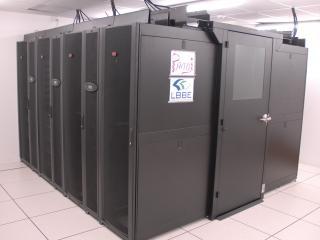Computing services
Members
Ingénieur d'études
CNRS
Tel: 04 72 44 81 42

Ingénieur d'études
CNRS
Tel: 33 04 72 43 11 68

Ingénieur d'études
CNRS
Tel: 04 72 43 35 82

Technicien
UCBL
Tel: 33 04 72 43 29 04

Ingénieur d'études
CNRS
Tel: 33 04 72 43 29 04

Ingénieure de recherche
UCBL
Tel: 33 04 72 44 85 98

Ingénieur de recherche
CNRS
Tel: 33 06 82 87 93 59

Ingénieur de recherche
CNRS
Tel: 33 04 26 23 44 70
info@listes-lbbe.univ-lyon1.fr
The "Pôle informatique" (hereafter called "PI") is constituted of 8 engineers (1T, 4IE, 3IR). Our activities are distributed among three main directions: computing and storage infrastructure management (shared resources, and invidual equipment), software and service development and data analysis in molecular biology and ecology.
Infrastructures managment
- Microcomputing: the PI is in charge of managing the laboratory's microcomputer equipment, from choosing the most appropriate solution in consultation with the future user to managing maintenance, including installation and configuration of the equipment.
- Laboratory Information System: the PI provides laboratory and community members with a number of services, including several web servers (apache), numerous database servers (relational or indexed) and several collaborative tools (Git, Redmine, Seafile...). These services are hosted on largely virtualized machines.

- Compute and storage: since 2009, the PI manages a computing cluster with almost 1200 avalaible computing cores. The cluster is linked to a 600 TB high performing distributed storage system under BeeGFS and an object mode storage based on iRods (~400 useful TB).
- Cloud and containerization: cloud-girofle (224 vcpu and 120 To), the local cloud operated by the PI since 2017, is part of the Biosphere cloud federation from the French Institute of Bioinformatics (IFB). We are starting to converge our virtualization infrastructure towards containerization technologies (docker, singularity).
- User support: the PI provides user support for all the resources and tools available to the laboratory's members. It trains and supports users in their use of shared resources through trainingsessions, information and monitoring meetings and mailing lists.
Software and methodological development
Members of the PI are involved in numerous software development projects in collaboration with the lab researchers, covering a large range of programming languages (R, Python, C++, OCaml, Javascript, SQL, shell). It goes from optimized parallel numerical codes to web services and dedicated databases (SQL or no-SQL). A peculiar effort is also performed to share the best practices of modern software development and make these software codes reproducible and available following the standards and requirements of the community.
Data analysis
Members of the PI are in the front line facing the data avalanche (and the data diversity) of this decade.
A large part of our activity is related to the quantity of data coming from sequencing technologies. The PI develops and proposes pipelines for genomic data assembly and annotation, RNA-seq and RAD-seq data analysis. More recently, computer image processing has become an important issue for future ecological studies performed in the lab in the Evolutionary Ecology.
Animation, training and scientific expertise
Our group has set up a series of dedicated workshops to improve internal skills in software engineering, distributed computing, programming and data analysis, which complements more formal teaching sessions. Members of the group are also involved in training activities in universities (UCBL1) and CNRS (Formation permanente).
In their respective fields, members of the PI actively monitor technological developments and participate in major events such as JOBIM (bioinfo), the JRES (system administration), the JDEV (development), the Aramis days (system and network administration and software development) and the 'Rencontres R' (programmation). The PI is also involved in dedicated networks and/or projects of national scope such as the LyonCalcul group, the RLyon group and the IFB-NNCR and IFB-Core projects.
We works in close cooperation with the bioinformatics platform PRABI (Pôle Rhône-Alpes de BioInformatique), notably for the management of the computing and storage infrastructure, the diffusion of our lab's software production, the organization of teaching sessions and for sharing expertise in genomic/transcriptomic data analysis.
Poster
Publications
Display of 61 to 90 publications on 170 in total
Detecting adaptive convergent amino acid evolution
Philosophical Transactions of the Royal Society B: Biological Sciences . 374 ( 1777 ) : 1-11
Journal article
see the publicationModelling of omics dose-response data for ecological risk assessment
Journées du GDR Ecologie Statistique (EcoStat) .
Conference paper
see the publicationNew goodness-of-fit plots for censored data in the package fitdistrplus
7ème rencontres R .
Conference paper
see the publicationPollen limitation as a main driver of fruiting dynamics in oak populations
Ecology Letters . 22 ( 1 ) : 98-107
DOI: 10.1111/ele.13171
Journal article
see the publicationGearing up to handle the mosaic nature of life in the quest for orthologs
Bioinformatics . 34 ( 2 ) : 323-329
Journal article
see the publicationDRomics: A Turnkey Tool to Support the Use of the Dose–Response Framework for Omics Data in Ecological Risk Assessment
Environmental Science and Technology . 52 ( 24 ) : 14461-14468
Journal article
see the publicationMaternal reproductive senescence shapes the fitness consequences of the parental age difference in ruffed lemurs
Proceedings of the Royal Society B: Biological Sciences . 285 ( 1886 ) : 20181479
Journal article
see the publicationMOSAIC : une plate-forme web pour l’analyse statistique des données d’écotoxicologie. Fiche Thématique N°13
: 4 p.
Persistent Interactions with Bacterial Symbionts Direct Mature-Host Cell Morphology and Gene Expression in the Squid-Vibrio Symbiosis
mSystems . 3 ( 5 )
Journal article
see the publicationMareyMap online: A user-friendly web application and database service for estimating recombination rates using physical and genetic maps
Genome Biology and Evolution . 9 ( 10 ) : 2506-2509
DOI: 10.1093/gbe/evx178
Journal article
see the publicationadegraphics: An S4 Lattice-Based Package for the Representation of Multivariate Data
The R Journal . 9 ( 2 ) : 198-212
DOI: 10.32614/RJ-2017-042
Journal article
see the publicationResponse to Comment on "Robust Fit of Toxicokinetic-Toxicodynamic Models Using Prior Knowledge Contained in the Design of Survival Toxicity Tests
Environmental Science and Technology . 51 : 8202-8203
Journal article
see the publicationRobust Fit of Toxicokinetic-Toxicodynamic Models Using Prior Knowledge Contained in the Design of Survival Toxicity Tests
Environmental Science and Technology . 51 : 4038-4045
Journal article
see the publicationAncestral Genome Estimation Reveals the History of Ecological Diversification in Agrobacterium
Genome Biology and Evolution . 9 ( 12 ) : 3413 - 3431
DOI: 10.1093/gbe/evx255
Journal article
see the publicationMaxTiC: Fast Ranking Of A Phylogenetic Tree By Maximum Time Consistency With Lateral Gene Transfers
DOI: 10.1101/127548
Other publication
see the publicationLes Ateliers Pratiques Numériques en SHS des laboratoires lyonnais
Forum Humanités Numériques et données ouvertes .
Poster
see the publicationFruiting Strategies of Perennial Plants: A Resource Budget Model to Couple Mast Seeding to Pollination Efficiency and Resource Allocation Strategies
The American Naturalist . 188 ( 1 ) : 66-75
DOI: 10.1086/686684
Journal article
see the publicationQuantitative Molecular Detection of 19 Major Pathogens in the Interdental Biofilm of Periodontally Healthy Young Adults
Frontiers in Microbiology . 7 : 840 - 840
Journal article
see the publicationRiboDB database: a comprehensive resource for prokaryotic systematics
Molecular Biology and Evolution . 33 ( 8 ) : 2170--2172
Journal article
see the publicationSNP calling from RNA-seq data without a reference genome: identification, quantification, differential analysis and impact on the protein sequence
Nucleic Acids Research .
DOI: 10.1093/nar/gkw655
Journal article
see the publicationNo Evidence That Nitrogen Limitation Influences the Elemental Composition of Isopod Transcriptomes and Proteomes
Molecular Biology and Evolution . 33 ( 10 ) : 2605–2620
Journal article
see the publicationL'enseignement et la formation au logiciel R : un retour d'expérience
Séminaire "R à l'usage des sciences sociales" (RUSS) .
Conference paper
see the publicationRAR/RXR binding dynamics distinguish pluripotency from differentiation associated cis-regulatory elements
Nucleic Acids Research . 43 ( 10 ) : 4833--4854
DOI: 10.1093/nar/gkv370
Journal article
see the publication